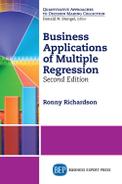Imagine that you are a business owner with a couple of years’ worth of data. You have monthly sales figures, your monthly marketing budget, a rough estimate of the monthly marketing budget for your major competitors, and a few other similar variables. You desperately want this data to tell you something. Not only that, you are sure it can give you some business insights if you know more. But what exactly can the data tell you? And once you have a clue what the data might tell you, how do you get to that information?
Really large companies have sophisticated computer software to do data mining. Data mining refers to extracting or “mining” knowledge from large amounts of data.1 Stated another way, data mining is the process of analyzing data and converting that data into useful information. But how, specifically?
While data mining uses a number of different statistical techniques, the one we will focus on in this book is multiple regression. Why study multiple regression? The reason is the insight that the analysis provides. For example, knowing how advertising, promotion, and packaging might impact sales can help you decide where to budget your marketing dollars. Or knowing how price, advertising, and competitor spending affect demand can help you decide how much to produce. In general, we use multiple regression either to explain the behavior of a single variable, such as consumer demand, or to forecast the future behavior of a single variable, such as sales.
Before you can understand the operation of multiple regression and how to use it to analyze large data sets, you must understand the operation of two simpler techniques: correlation analysis and simple regression. Understanding these two techniques will greatly aid your understanding of multiple regression.
Correlation analysis measures the strength of the linear relationship between a pair of variables. Some pairs of variables, such as sales and advertising or education and income, will have a strong relationship whereas others, such as education and shoe size, will have a weak relationship. We will explore correlation analysis in more detail in chapter 1. As part of that discussion, we will see what it means for a relationship to be linear as well as what it means for the relationship to be strong or weak and positive or negative.
When a pair of variables has a linear relationship, simple regression calculates the equation of the line that describes that relationship. As part of simple regression, one variable will be designated as an independent, or explainer, variable and the other will be designated as a dependent, or explained, variable. We will explore simple regression in more detail in chapter 2.
Sometimes, a single variable is all we need to explain the behavior of the dependent variable. However, in business situations, it almost always takes multiple variables to explain the behavior of the dependent variable. For example, due to the economy and competitor actions, it would be a rare business in which advertising alone would adequately explain sales. Likewise, height alone is not enough to explain someone’s weight. Multiple regression is an extension of simple regression that allows for the use of multiple independent or explainer variables. We will explore multiple regression in more detail in chapter 3.
When using multiple regression with its multiple independent variables, we face the issue of deciding which variables to leave in the final model and which variables to drop from the final model. This issue is made complex by the “diseases” that can affect multiple regression models. We will explore building complex multiple regression models in more detail in chapter 4. It is when we get to model building that we will begin to see the real-world use of multiple regression.
This book assumes you have a background in statistics. Specifically, we will use the normal distribution, Student t-distribution, and F distribution to perform hypothesis tests on various model parameters to see if they are significant. While it is helpful if you are familiar with these concepts, it is not essential. The software today is advanced enough to present the results in such a way that you can easily judge the significance of a parameter without much statistical background. A brief review is provided in chapter 1.
Correlation, simple regression, and multiple regression can all be performed using any version of Microsoft Excel. Most readers will be able to perform all their analyses in Excel. However, some of the advanced features of multiple regression require an actual statistical package. There are many fine ones on the market, and any of them will perform all the techniques we will discuss. The examples in this book are all either from Excel or from a statistical package called SPSS.
